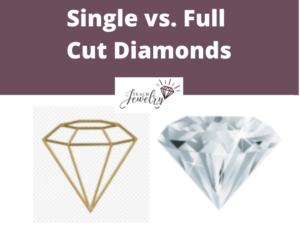
One of the distinguishing features of a diamond is its cut and whether it’s a single cut or a full cut. These terms refer to the faceting type used on smaller diamonds that give the diamond its detailed look.
Read below to learn about each type, their pros and cons, and how you should go about deciding which type is right for you.
What are Single Cut Diamonds?
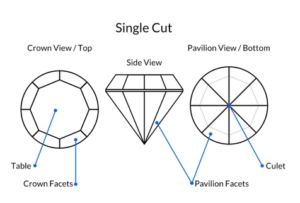
Single cut diamonds are round brilliant diamonds with fewer than 57 or 58 facets. Most single cut diamonds will have 16,17, or 18 facets.
One common design is referred to as an 8/8 arrangement because there are eight facets with the crown, eight on the pavilion, and then the table facet. So this arrangement has 17 total facets.
Single cut diamonds were more popular before diamond-cutting technology improved in the 1970s. With new technology, jewelers are able to cut additional facets into small diamonds and turn them into full cuts with better light performance.
Diamonds under 10 points (0.10 carats), where the number of cuts will not affect the overall appearance due to its smaller size, are generally the ones that remain single cuts.
They aren’t only found in diamond rings. You can also find single cut diamonds in earrings, bracelets, pendants and watches. But when placed in a diamond ring, they often serve as accents, side stones, or as a pave setting.
What are Full Cuts?
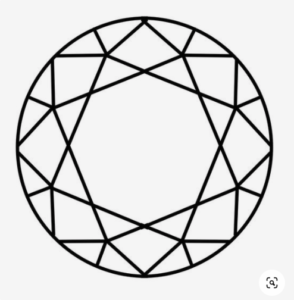
Full cut diamonds are round brilliant diamonds with 57 or 58 facets. While there may be some diamonds with more or fewer, the standard for full cut diamonds is 57 or 58.
These diamonds are first cut as single cuts, and then more are added to make it a full cut. They’re usually larger than single cut diamonds, as the full cut design accentuates the overall aesthetic of larger diamonds for a more sophisticated look.
Full cut diamonds generally come at a higher cost due to the necessity of the jeweler making additional, complex cuts.
Full cut diamonds first came on the scene in the 1980s and are the most popular design used today.
Advanced technology allowed diamond cutters to translate 57-58 facets on brilliant diamonds that weighed in at 0.10 carats and smaller. As the decade came to an end, most cutters had adopted this new style, making full cuts the new standard and phasing out single cuts.
Full cuts used on smaller diamonds sometimes go unnoticed at first due to their small size, so this design is usually reserved for larger brilliant diamonds.
Pros of Single Cut Diamonds
While a full cut diamond is the standard for most brilliant diamonds, there are still reasons consumers choose single cuts.
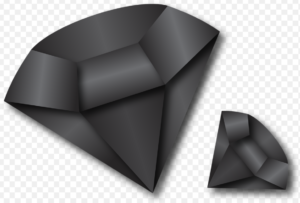
First, single cuts are often cheaper than full cuts because the additional cuts aren’t added. This can be a time-consuming, detailed process for jewelers, which adds to the overall costs.
Relatedly, single cuts are preferable when those diamonds will not be the main show, such as when used as accents or in a cluster, pave, or channel design. These diamonds are often small enough to where it’s not worth the extra cost for a full cut because the difference is indistinguishable to the naked eye.
Another advantage of single cuts diamonds is they can be used for custom, high-end designs. That may sound counterintuitive when looking at their prices, but because single cuts are more rare, it can offer a unique look that stands out from the typical piece built with full cut diamonds.
Surrounding your center stone with single cut diamonds will cause the stone to stand out and sparkle in a way it wouldn’t if it were surrounded by other high-performing diamonds. In a similar way, if you choose a more subdued stone such as emeralds, rubies, or sapphires, a softened single cut diamond can serve as the right complement.
Cons of Single Cut Diamonds
There are reasons single cut diamonds aren’t sold by jewelry retailers as often. The primary reason is because they aren’t as practical when the diamond is the focal point of the ring. Center stones should have strong light performance, and that’s the main disadvantage.
There are fewer facets for light to bounce from, so it sparkles less than a full cut.
It’s uncommon for an engagement ring to feature a prominent, single cut diamond. Instead, you’ll more often see them as accents or on the shank.
Pros of Full Cut
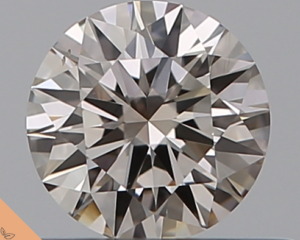
The advantage of a full cut diamond is it offers a superior look compared to single cut diamonds.
The additional facets add more flair to the diamond and allow it to reflect light more beautifully than a single cut diamond. When you twirl the diamond around, it has a stronger glimmer.
That’s why it’s far more common to have the most prominent diamond on a ring be a full cut.
Cons
There aren’t many downsides to a full cut diamond, and that’s why it’s far more popular than a single cut. The primary disadvantage is they’re often more expensive because of better light performance and the time and effort it takes to make the extra cuts.
It’s also reasonable to avoid a full cut if you don’t want its shine to contrast or hide from the other gems in the piece. If the center stone is a softer gemstone, you may not want to detract from its appeal with a shinier full cut diamond right next to it.
How Does it Affect Price?
A single cut diamond is usually cheaper than a full cut because it takes less time and effort to manufacture. Adding 30+ facets to a diamond doesn’t come free.
However, the price of single cut diamonds has risen in recent years thanks to watch manufacturers. Single cut diamonds are used often in high-end watches, decreasing the overall supply.
That being said, you can often find single cut diamonds between $100-$200, depending on the carat, clarity and cut. A high-graded cut and more carats are what really increase the price of a diamond, so with a single cut, you avoid raising the price too much.
How to Decide Between Single and Full Cut
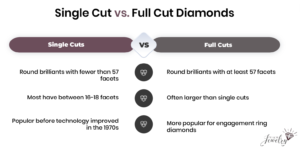
When choosing a single versus full cut diamond, take into consideration the diamond’s placement on the ring, your overall desired look, and your budget.
If you’re selecting a diamond that will sit as the center stone on the ring, a full cut diamond is a way to go. The attention will be on the diamond, so you want it to have exceptional sparkle.
If you’re choosing accents to complement the main diamond, single cut diamonds are a popular choice and won’t detract from the center.
Either way, it’s important to be intentional about the decision and know the differences between a single and full cut, so you can shape the piece of jewelry exactly the way you want it.

Jacob Clarke
Jacob Clarke is the founder of TeachJewelry.com.
He earned an Applied Jewelry Professional Diploma from the Gemological Institute of America (GIA) and now brings you essential information about diamonds, settings, and more.
Jacob has consulted with leading jewelry brands, and his work has been cited in Clean Origin, Diamond Nexus and industry publications.
He's also a member of the International Gem Society.
He enjoys discussing jewelry with readers, so contact him with any questions at jacob.clarke@teachjewelry.com.













